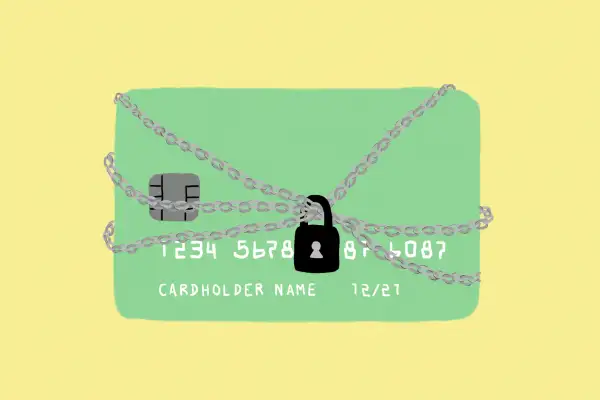How to Train Your Brain to Stop Making Impulse Purchases, According to a Financial Psychologist

Combine a pandemic that’s kept us cooped up indoors with an unusually cold winter and what do you get? A perfect recipe for some highly questionable online impulse purchases.
Maybe you can’t stop hunting for a cocktail dress to wear at those summer weddings you may-or-may-not attend. Or maybe you suddenly find your AmazonBasics kitchenware lacking in comparison to the celebrity chefs you’ve taken recipe inspiration from. Either way, if you feel like your online shopping has been more out of control than usual, you’re not alone: Consumer spending on e-commerce platforms shot up 44% over the past year, according to information from the U.S. Commerce Department.
Financial experts will tell you that if you want to curb unnecessary spending, you need to unsubscribe from marketing emails, block websites, and delete your credit card information from your browser. It’s sound advice that does the trick for many — but sometimes these tips can backfire or simply not go far enough. (Not to point any fingers, but this author may or may not have accidentally memorized her own credit card number from manually typing it in too many times.)
So if you’re a fellow member of the credit card memorization club who’s still spending more online than you’d like to, then you may need to replace easy hacks with more long-lasting habits rooted in behavioral psychology.
“I don’t think [easy hacks] are nearly as helpful as understanding why you’re doing it in the first place,” says Brad Klontz, a financial psychologist and certified financial planner.
Here’s what to know about the psychology behind impulsive shopping and how to use that knowledge to create better habits.
Be conscious of your decision-making process
Most people would like to consider themselves rational beings, making decisions without letting their emotions get in the way. But behavioral economists have some harsh truth: that simply isn’t true. And when it comes to shopping, external players are actually encouraging you to act irrationally.
“Marketers are experts at triggering you emotionally to get you to spend your money,” Klontz says.
In the digital age, where everywhere you click is seemingly a never-ending maze of email alerts and carousel ads, it can be downright impossible to avoid getting wound up, worrying you might miss out on a great deal.
“When we become emotionally charged, we become rationally challenged,” Klontz says. “Our prefrontal cortex becomes impaired.”
The prefrontal cortex is the area of your brain responsible for decision-making, and engaging it to get ahead of what triggers you to spend requires vigilance. Luckily, while the prevalence of online shopping can hinder peoples’ ability to think rationally, it also offers benefits that you can’t take advantage of in-store. Tricks like letting your cart sit for 24 hours or disabling alerts from stores can force us to reflect on whether or not it’s a good spending decision.
But managing your decision-making works best when you can individualize the experience. One way to do this is to take stock of what tends to be your go-to categories for impulsive spending and create specific parameters for what makes a purchase justifiable. For example, if shoes are your vice you might ask yourself: Can I wear them with X amount of outfits? Do I already have a similar pair that serve a similar function? Will they last for more than one season? And so on.
If you can honestly answer whatever questions you decide are important with qualifications that make spending the money worthwhile, then you’ll be less likely to cave when presented with the opportunity to make an impulsive purchase.
Train your brain to prioritize long-term gains...
What does buying a brand new KitchenAid mixer have to do with your ancestors foraging for berries to keep from starving? A lot, actually.
“So much of what we do around money and life relates back to what I call our ‘cave person’ brain,” Klontz says.
No, we don’t need to stockpile months’ worth of resources to protect our clan from outside threats, but the biological drive that motivates these survival behaviors appears to have a hand in the way people make shopping decisions.
Animals — including humans — have reward centers in their brains that respond to the “feel good” hormone dopamine when they acquire something they want or achieve a goal. Using that heightened sense of reward to your advantage by reorienting your priorities from buying something new to meeting more essential long-term financial goals could be the key to curbing unnecessary spending.
Klontz suggests those who find themselves overspending take stock of their overall financial health first and set goals from there: “Most people aren’t paying themselves first. That’s where the problem arises.”
Many financial advisors encourage people to follow the 50-30-20 breakdown: put 50% of your net income toward living expenses, 30% toward discretionary spending (aka fun money), and 20% into savings. If that last category isn’t up to par or you aren’t contributing a substantial amount to a retirement plan, Klontz says it should be your top priority before any unnecessary lifestyle upgrades.
But working to build a strong savings can still satisfy our natural inclinations to gather and protect — it just requires training. According to research from Santa Clara University, while a small portion of people have a genetic predisposition to save more due to a stronger link between their short-term and long-term thinking processes, the majority of us can get there by gradually rewiring our brain to prioritize long-term outcomes over short-term gains. The researchers found, for example, that when people were given tools to help them pre-commit to put more money in their savings accounts months in advance, they were more likely to accomplish the task and feel more positive about saving rather than spending.
Financial goal-setting apps that track your saving progress like YNAB, Mint or a good old-fashioned spreadsheet can help you start to change the way you think about saving from a chore-like must-do to a goal you can continually look forward to.
… And earn your present-day rewards
If your financial house is in order, you’re meeting that 20% savings threshold and you still have money leftover, then “frankly, I don’t care what you do with the rest,” Klontz says.
But if you want to avoid accumulating a bunch of junk you won’t actually use — even if you have the money for it — then connecting the goal of saving for a big purchase to meeting goals in your personal or work life can deliver a powerful dopamine response more satisfying than making daily “trips” to Amazon.
Here’s how it works: Say you want to buy a $250 memory foam mattress topper, an upgrade to your current set-up that will get plenty of use. At the same time, you have to give a major presentation at work in two weeks that requires extra attention each day to prepare for it. If you set aside $25 every day you work on the project, you can time an exciting purchase alongside the completion of the presentation. The delayed gratification and association between a higher level of effort with a higher reward can train you to prioritize long-term satisfaction over a short-term thrill.
Another option is to keep a list of spending ideas that come to you throughout the day — but don’t go browsing for them yet. When you browse or even let something sit in your cart for a few days, Klontz says you’re more likely to be blasted with advertisements and price change alerts specifically designed to trigger feelings of scarcity, which can influence people to make choices they usually wouldn’t.
Instead, jot down every potential purchase that comes up throughout the week and pick a dedicated day to comb through them to decide if you want to fork over the cash. Putting some distance between when the idea strikes you and when you actually hit ‘buy’ allows you the time to think through spending decisions and compare which items on your list will be most valuable to you.
If your finances are secure, there’s no need to deprive yourself of a fun splurge every now and then. It’s just about knowing how to keep yourself in check when faced with tempting offers.
More from Money:
The New Investor's Survival Guide: How to Make Money (and Stay Sane!) in Today's Wild Markets
